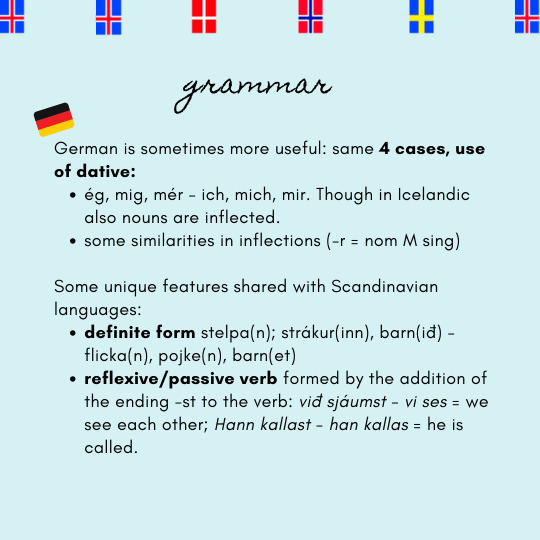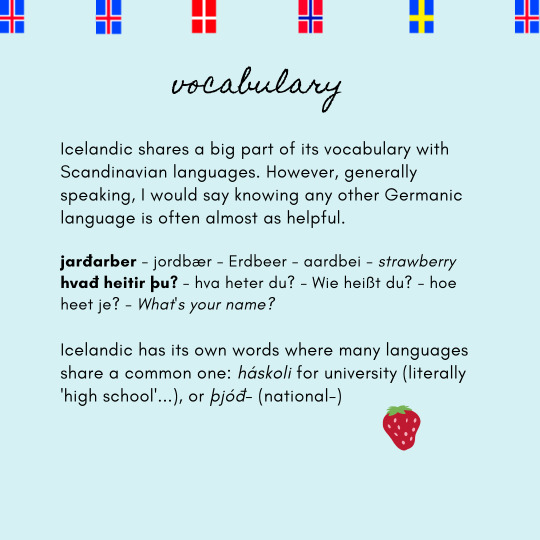ENG: Mutt/Hound/Puppy ♡ it/its ♡ schizophrenic endel, werewolf & wolfdog ♡ median system, bpd/autism/dyslexia ------------------------------------------ NOR: Mutt/Hound/Puppy ♡ Det/Dets ♡ Schizofrene Endel, varulv & ulvehund ♡ median system, BPD / autisme / dysleksi
Don't wanna be here? Send us removal request.
Text





Wrote an article about What learning Icelandic is like if you already speak a Scandinavian language
Feel free to share your experience if you speak a Scandinavian language and have studied Icelandic ! 🇩🇰🇸🇪🇮🇸🇳🇴
11 notes
·
View notes
Note
are there "complications" in norwegian like there are in english? i.e. "then and than," "there, they're, and their"?
Hello helloooo! c:
((Not 100% sure if you’re referring to just words that have the same pronunciation but different meanings, or simply common mistakes/words people tend to get mixed up in general, so I’ll try to go into both– sorry if I’m on the wrong track here! :c ))
There are quite a few actually!! I might be forgetting some of them, but I’ll try my best to cover the most common ones (this post is still gonna be very long though).
———————-
Common Mistakes in Norwegian
——————
Da - Når
(( Made a separate and slightly-more detailed post about this over here! ))
“Da” and “når” can both be translated as “when”, but they’re not interchangeable in Norwegian:
“Da” - used when you’re referring to a specific point in time/an occurrence that has only happened once
“Når” - used when you’re referring to something that happens habitually OR something that will happen in the future. Sometimes similar to how one could use “whenever” in English”.
— examples. }}
– Specific point in time (da) –
“Da jeg kom hjem igår, var middagen allerede klar.” –> “When I came home yesterday, dinner was already ready.”
– Habitual (når) –
“Når jeg kommer hjem, bruker middagen å være klar.” –> “When(ever) I get home, dinner is usually ready.”
– Future (når) –
“Når jeg kommer hjem idag, burde middagen være klar.” –> “When I come home today, dinner should be ready.”
——————
Ennå - Enda
“Ennå” and “enda” can both be used as adverbs of time, and are then often translated as “yet”. In these cases, they’re interchangeable.
However, “enda” can also be used as an adverb of degree or, occasionally (though rarely), a conjunction. On the other hand, “ennå” can only be used as an adverb of time, but many people get them mixed up.
When “enda” is used as an adverb of degree, it’s often translated as “even”. When it’s used as a conjunction (which you’ll rarely see since it’s rather old-fashioned), it’s often translated as “even though”: It’s more common to use “selv om” in these cases.
— examples. }}
– Adverb of time –
“Han er ikke her ennå/enda” - “He’s not here yet.”
– Adverb of degree (enda) –
“Jeg spiste enda mer.” - “I ate even more.”
– Conjunction (enda) –
“Han kom på skolen, enda han var syk.” - “He came to school, even though he was ill.”
——————
Får - For
“Får” and “for” are both written and used differently – however they’re often pronounced the same, which can be confusing when you need to remember which one to write/use where.
“Får” is the present tense of the verb “å få”, which means “to get” or “to receive”.
“For” can be used as a preposition or a conjunction. As a conjunction it’s pretty much identical to “fordi”.
— examples. }}
– Verb (får) –
“Jeg får alltid gave fra mormor på bursdagen min” - “I always get a present from grandma on my birthday.”
– Preposition (for) –
“Det er umulig for meg å forstå.” - “It’s impossible for me to understand.”
– Conjunction (for) –
“Jeg tok bussen, for jeg ville ikke være sen.” - “I took the bus, because I didn’t want to be late.”
**!! “Får” can also be a noun, in which case it’s a synonym for “sheep” (though it’s usually more common to use “sau”, but it depends– when you’re talking about meat, for example, it’s often more common to use “får”).
**!! There��s also a similar-looking word, “fôr”, which can mean either “feed” (noun) or “the innermost layer (often wool) of warm clothing” (not sure if there’s a specific word for it in English..??o: )
——————
En - én / ei - éi / et - ett
(( Made a separate and slightly-more detailed post about this over here! ))
“En”, “ei” and “et” are articles. “En” is for masculine nouns, “ei” is for feminine nouns, and “et” for neuter nouns.
“Én”, “éi” and “ett” means “one”. “En” is for masculine nouns, “ei” is for feminine nouns, and “ett” for neuter nouns.
— examples. }}
– Articles (en, ei, et) –
“Jeg har en katt.” - “I have a cat.”
“Han har et hus.” - “He has a house.”
“Hun har ei dukke.” - “She has a doll.”
– Counting (én, éi, ett) –
“Jeg har én katt.” - “I have one cat.”
“Han har ett hus.” - “He has one house.”
“Hun har éi dukke.” - “She has one doll.”
——————
Hver(t) - Vær - Være (vært) - Vert
Now this one can be tricky, because “hvert”, “vært” and “vert” are pronounced the same, and “vær” and “hver” are pronounced the same – but they all have quite different meanings, which can be confusing.
“Vær” is a noun and can either mean “ram” or “weather” depending on the context. It can also be the imperative mood of the verb “å være”.
“Vert” is a noun and means “host”.
“Vært” is the perfect tense of the verb “å være”, which means "to be”.
“Hver” and “hvert” are determinatives which translate as “every” or “each”. “Hver” is for masculine and feminine nouns, while “hvert” is for neuter nouns.
— examples. }}
– Nouns (vær, vert) –
“Fint vær i dag!” - “Nice weather today!”
“Er det en vær der borte?” - “Is there a ram over there?”
“Jobber du som vert?” - “Do you work as a host?”
– Verbs (vær, vært) –
“Vær snill!” - “Be nice!”
“Hvor har du vært?” - “Where have you been?”
– Determinatives (hver, hvert) –
“Hvert eneste barn må spise!” - “Each and every child must eat!”
“Jeg spiser brød hver dag.” - “I eat bread every day.”
——————
Lenger - Lengre
This one might get tricky– but I’ll try my best.
“Lenger” and “lengre” can both mean “longer” (though sometimes “lenger” can mean “far”) and they’re both comparatives. However “lenger” is a comparative adjective (from the adjectives “langt” and “lenge”), while “lengre” is a comparative adverb (from the adverb “lang”).
To make it easier: if you’re referring to time or a verb, use “lenger”. If you’re referring to a noun or a pronoun, use “lengre”.
— examples. }}
– Time/verbs (lenger) –
“Jeg har vært her lenger enn deg.” - “I’ve been here for longer than you.”
“Vi gikk litt lenger.” - “We walked a bit further.”
– Nouns/pronoun (lengre) –
“Bordet var lengre enn jeg husket.” - “The table was longer than I remembered.”
——————
Ovenfor - overfor
They’re both prepositions, but “ovenfor” means “above”, while “overfor” means “opposite”, “against” or “facing”.
— examples. }}
“Jeg satt ovenfor henne.” - “I sat above her.”
“Jeg satt overfor henne.” - “I sat facing her.”
——————
Viste - Visste
They’re both the past tense of verbs, but “viste” means “showed” (from “å vise”- “to show”), and “visste” means “knew” (from “å vite” - “to know”).
— examples. }}
“Jeg visste det!” - “I knew it!”
“Jeg viste det til henne.” - “I showed it to her.”
——————
I hope that’s what you meant!! c: If anyone else can think of more, please feel free to add them to this post!
-
667 notes
·
View notes
Note
Can you recommend me some good norwegian songs? I speak spanish and i'm trying to learn norwegian.
my current favourites from my ‘norwegian in norwegian’ playlist (keep in mind some of these are sung in different dialects):
“her” - karpe diem“kan du lære mæ?” - kristian kristensen“riv i hjertet” - sondre justad“alle snakker sant” - siri nilsen“vår beste dag” - marit larsen“fredag” - kjartan lauritzen“lørdag” - emile the duke“du fortenar ein som meg” - daniel kvammen“sansen” - tôg“ås to i osjlo” - ravi“årner sæ” - ravi/jo nesbø“hjerteknuser” - moi
you could also try searching for “norsk på norsk” on spotify
458 notes
·
View notes
Text
main is @moribundkills
Name: Mutt/Hound/Puppy
Pronouns: it/its (headmate specific can be found on pronouns.cc in here)
IDs/DX: bpd, amnesia, schizophrenia/schizoaffective bpd, auDHD, possible npd, chronic pain/unknown physical disability, median system
Communication info: do not try to befriend me; I am disabled and it may take me a while to get back to you
In depth about, byf, etc:
hello ! We are Mutt/Hound/Puppy, a median system of a couple werewolves. This blog was made for a few things, most notably norwegian practice. We also wanted a discourse free blog were we can all post and what not. // hei ! Vi er Mutt / Hound / Puppy, et median system av et par varulver. Denne bloggen ble laget for et par ting, spesielt norsk praksis. Vi ønsket også en diskurs gratis blogg hvor vi alle kan legge inn og hva ikke.
Other blogs:
Maximus: @moribundkills
Døende: @bloodymori
Angel: @wingedpups
byf:
We are psychotical/delusional & schizophrenic, ALL P-SHIFTERS WILL BE BLOCKED (sideblogs are fine as long as we see you do not engage with psychotic people/tag your posts/etc). We have kosmemophobia, please tag your posts with jewelry in some way so we can avoid it. We have discourse opinions, we just arent sharing them here. If it matters that much to you, you can check Maximus' blog for those opinions. // Vi er psykotiske / vrangforestillinger & schizofren, ALLE P-SHIFTERS VIL VÆRE BLOKKERT (sideblogger er fine så lenge vi ser du ikke engasjere seg med psykotisk folk / tagg innleggene dine / etc). Vi har kosmemophobia, vennligst merk innleggene dine med smykker på noen måte slik at vi kan unngå det. Vi har diskurs meninger, vi er bare ikke deler dem her. Hvis det betyr så mye for du, du kan sjekke Maximus ' blogg for de vurdering.
Other:
Each headmate has a different appearance, most common is Maximus' which is a human leaning werewolf (can be found on @strawberryhound ). Feel free to draw fanart!! // Hver rektor har et annet utseende, mest vanlig Er Maximus ' som er en menneskelig skjev varulv (finnes på @strawberryhound). Du er velkommen til å tegne fanart!!
2 notes
·
View notes
